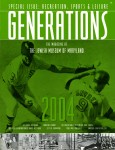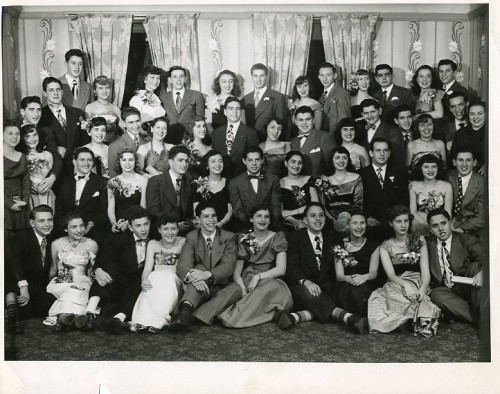The Dancing Schools of Baltimore’s Jewish Society Part 2

 Article by Gil Sandler. Originally published in Generations – 2004: Recreation, Sports & Leisure. This particular issue of Generations proved wildly popular and is no longer available for purchase.
Article by Gil Sandler. Originally published in Generations – 2004: Recreation, Sports & Leisure. This particular issue of Generations proved wildly popular and is no longer available for purchase.
Part II: Not Always Genteel
Missed the beginning? Start here.
But the dancing school experience was not always a genteel one: Francois Roos (“Frenchy”) Snyder remembers her dancing school classes at Mrs. Finley Burns’s school at the Stafford Hotel, Charles at Madison Streets, later at the Phoenix Club on Eutaw Place, in the 1930s. “It could be nerve wracking,” she says. “The class worked on the ‘dance card’ system. Each girl had a dance card, with room on it for ten partners to sign up to dance with you. I was always so worried that my dance card would not be filled.” Albert Berney was one of those who wrote on “Frenchy” Snyder’s dance card. He recalls: “I danced with her, and I thought she was a pretty good dance.”

Mrs. Snyder recalls: “In my class were Moses Morris, Norman Cohen, Julian Katzenberg, Gene Blum, Herman Frank, Alice Rosenbush, Mary Louise Fleishman, Louis SInsheimer, Etta Scherlis, Dick Hutzler, Sarahh Westheimer, Ellen Berney, and Julian Stein.”
“It was all very formal. Boys were taught how to ask a girl for a dance and the girls, how to accept. The boy might approach the girl and say, ‘May I please have this dance? And then she might say, ‘I would love to.’ Manners were a part of what you were supposed to learn in dancing class.”
In 1938, 13-year-old Morton Marcus attended Bea Goodhart’s and Aileen Straus’s dancing school. In his class were Stanley Greenebaum, Richard Hess, Virginia Watner Gordon, Louise Gutman Goldberg, Dick Chessler, Malcolm Rudolph, Myra Levenson Askin, William Kahn, Alice Berney Hoffberger, Peggy Mayer, and Carol Neuberger Dupkin. Morton recalls, “If there was such a thing as flunking out of dancing school, they would have flunked me. I couldn’t learn to dance, and in all the classes I went to, only one girl asked me to dance – Nina Bernheimer. She always work a fleecy white sweater, and I always wore my dark blue Bar Mitzvah suit, and when we danced all of those long, white hairs off of her sweater would shed all over my dark suit. I didn’t like that at all.” His wife of 50 years, Marilyn, says, “For a guy who says he didn’t like dancing class, he still talks about dancing with Nina Bernheimer. It’s been fifty years.”
Margie Katzenstein Greenebaum went to the Straus-Goodhart’s in the late 1930s. “The dance usually started with the girls lined up on one side, and the boys on the other. And on the signal, the lines broke and the boys sought out partners. The arrangement made me nervous. Suppose no boy asked me to dance?”
“Of course, you learned ballroom dancing. And manners. How to be polite. But really, what the dancing school was all about was our parents’ desire to have us meet what they considered to be the ‘proper’ people.
“In my class were Joan Bette, Seff Offit, and Barbara Blaustein Hirschhorn. Looking back, it was a good experience. To this day I meet people and we recognize each other from dancing class. We all made social contacts that we kept the rest of our lives.”
Jerome (“Jerry”) Trout attended Mesdames Straus and Goodhart’s dancing classes in 1942. His memories of the experience square with some of the others who shared in it: dancing classes of that crowd were not so much about the students as they were about the parents. “Not all of us were in Park School and in the Suburban Club,” he recalls. “Some of us were on the fringe of all of that. I went to Poly, and somehow lived without being in the Suburban Club. But when I was sixteen my parents, who appreciated the way the world worked even if I didn’t, and not being able to afford membership in the Club themselves, bought a ‘junior’ membership for me. They didn’t know that most of the time I was attending dancing classes I was figuring a way to get out of them.”
Louis Newman went to Mesdames Straus and Goodhart’s school, but insists he can’t remember anything about it. He says, “That’s because I hated it so. All the guys hated it. The whole thing was our parents’ idea. They just wanted us to meet the right people, to stay in their crowd. So every Saturday afternoon I had to get into my Isaac Hamburger dark suit and my Hess black shoes, and drive from Temple Gardens where we lived around the corner to Brooks Lane to pick up Babs Feustman. I didn’t mind picking her up – but I had to bring her flowers!”
Ellen Levi Zamoiski confirms the parental mandate with regard to attending dancing school: “It didn’t matter whether we wanted to go or not. Our parents wanted us to go and that was that.” In retrospect, the students may not have taken the dancing classes very seriously. But the parents certainly did.
Following WWII the winds of change whipped through Baltimore Jewish Society with hurricane force, sweeping away the pillars that supported what was known as “Jewish Society.” That “in-crowd” was about “old money,” but in post-war Jewish Baltimore, there was, suddenly, all this new money around, and much of it in the hands of many who had never heard of a Baltimore “in-crowd.” The firewall around Baltimore’s old-money, in-crowd came tumbling down. By the 1990s there were few traces of Jewish society’s creaky continuum. You didn’t need dancing school to get into the “in-crowd” because there was no “in-crowd” left to get into.
The Jewish dancing schools that once seemed so terribly important to Baltimore’s socially-aspiring Jewish families, for a hundred years up through the 1950s, are no more. The twelve, thirteen, and fourteen-year-old boys and girls who were so dutifully and seriously shepherded through this rite of passage are now grandparents in their seventies. What’s left are the stories: about this coming of age in a sugarplum world where manners and dance were thought to be the currency that bought into a lifestyle. That world, long ago and gossamer, has quietly faded with time, like a leftover dance card from Aileen Straus and Bea Goodhart’s dancing school, circa 1942.
